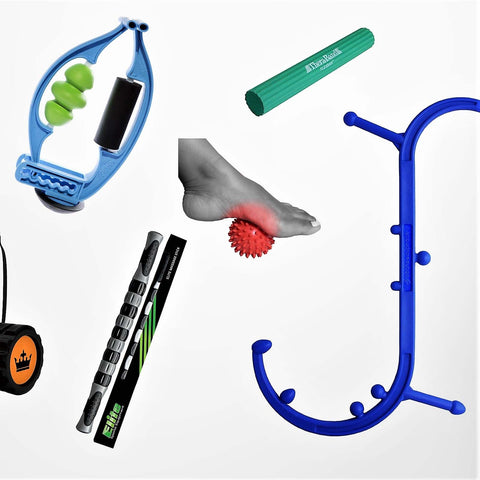Have you ever seen the designated finish line area for elite athletes? Filled with ice baths, Recovery boots and on-call masseuses—it's a far cry from the crowded fold-up tables stacked with bananas and water that we amateurs usually encounter.
To be fair, pro athletes are breaking down their bodies for a living, and staying in peak condition for the next race means recovery is as much a part of their daily lives as breathing. But still, even we mid-pack finishers are at risk for injury, illness and loss of performance if we don't recover properly. But how can you recover like a pro without quitting your day job? Here are five ways to stay ahead of the recovery curve:

Invest in a Portable PT Center
While some pro athletes visit a physical therapist weekly for active release massages and gait assessments, the average athlete doesn't have the time or budget. For less than $100, you can purchase an array of equipment that can stave off many of your post-race or heavy training injury nuances. Foam rollers start at around $30.
All of these items are small enough to fit in your transition or race bag, so after you cross the finish line, you can grab some water and a banana, then hit the ground for 15 minutes of active release, leading to less muscle soreness, reduced risk of injury and a shortened recovery time. Just keep in mind that if after a week of recovery and foam rolling you're still feeling pain, it's time to go see your doctor.
Think on the Micro-Level
Most people think that recovery involves only post-workout or race behavior, but in reality, recovery is something your body is doing constantly. One of the most overlooked ways to recover is through diet—specifically, micronutrient supplementation.
So what exactly are micronutrients? Unlike macronutrients (carbohydrates, fats and proteins) which are nutritional components we need in large quantities, micronutrients are incredibly beneficial minerals and vitamins we need in small dosages to orchestrate a range of physiological functions from immunity to fluid balance.
During a race, micronutrient supplementation involves taking in electrolytes like potassium and magnesium to keep your body hydrated and to regulate your blood's pH levels. Eating a balanced diet will keep your micronutrient levels in check, but during periods of heavy training or racing, micronutrient supplementation can improve your performance, prevent illness and decrease your overall recovery time. There are many philosophies out there regarding micronutrient supplementation and what works best for each individual.

Sleep on It
Many professional athletes sleep upward of nine to 10 hours a night (plus post-workout naps), and they're not doing it because of laziness. Sleep is when most of your body's recovery takes place. This is easier said than done for most age-group athletes who are juggling work, kids and training, but there are some sleep hacks you can use to make a difference in the quality of sleep you're getting.
Try getting into bed the same time every night, and waking up at the same time (or within an hour of it on weekends). Avoid watching TV or looking at a computer screen for an hour prior to going to sleep, as LCD screen light can stimulate your brain and make falling asleep harder.
Most importantly, if you're thinking of making due with five hours of sleep just to hit that early morning Masters workout—don't. Sleep is more important than any single workout you might complete, especially one done under massive fatigue.
Create Your Own "Race Entourage"
While pro athletes have a bevy of people on-hand to help them recover after a race, sometimes we mere mortals are stuck heading off to coach our kid's soccer game directly after crossing the finish line. This can make proper post-race recovery hard—but not if you get a little imaginative.
Ask your spouse or partner to bring you some ice, compression socks and a healthy protein snack post race, and find a nice spot away from the finish line festivities where you can do some foam rolling, ice your muscles and spend some nice time with them. Spectating at a triathlon or marathon is hard work, too, so take the time to thank them and ask them about how they're doing.
Make your active recovery days even more rewarding by going for a stroll or easy bike ride with your kids. By involving your "entourage" in your racing and training life, you keep it light and fun for the whole family, and they'll be more likely to want to come and support you at more races.

Schedule Recovery Days
Whether you're training for an IRONMAN or dipping your toes in the sport of triathlon for the first time, it's easy to get sucked into the over-training mentality. While being active every day is a positive thing, you should always keep in mind that scheduled recovery days are an essential part of any training plan.
Taking off one day a week to recharge your muscles and your mind will keep you happier, healthier and stronger in the long run. If you don't take days off, you risk falling into an over-trained state, where you might feel as if you're giving 100 percent in your workouts, but due to accumulated fatigue, you're only putting out 75 percent, which will limit and even backtrack many of your performance gains and often lead to injury or illness.
If you find that you feel antsy taking a day off, try scheduling them with a training buddy. Not only can you hold one another accountable, but you can also make plans to meet up for coffee or an easy stretch class.
By Susan Grant Legacki
